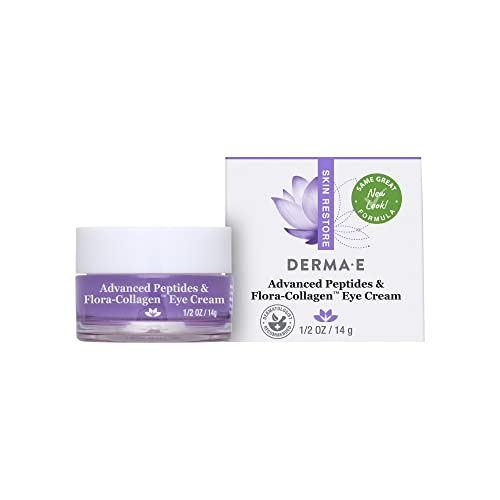
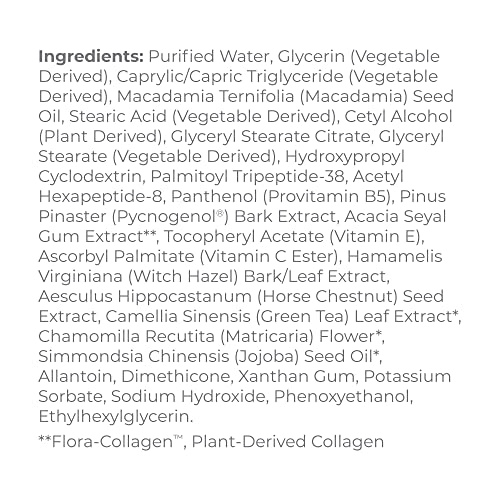
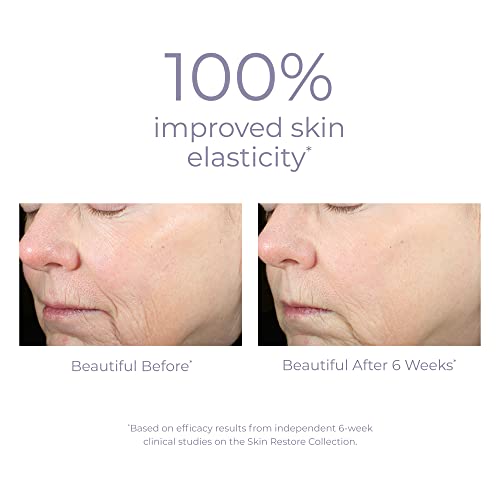
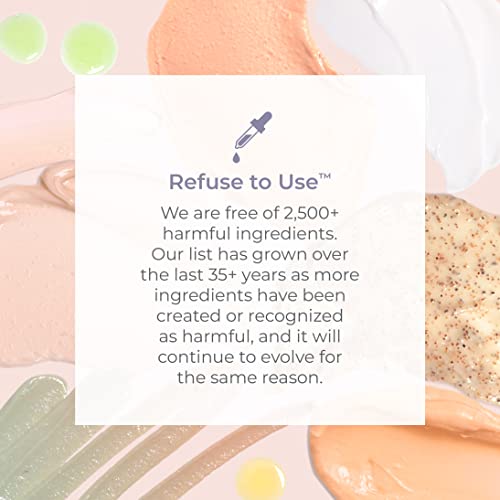
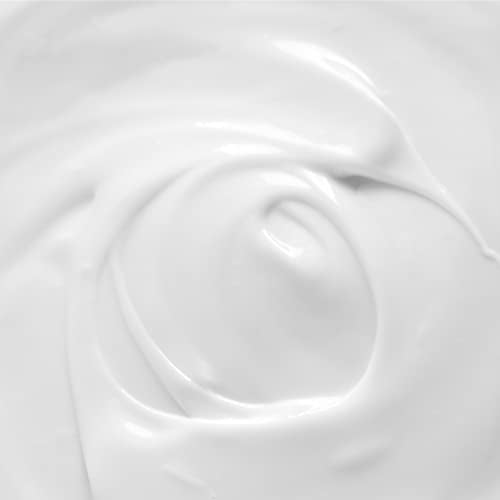
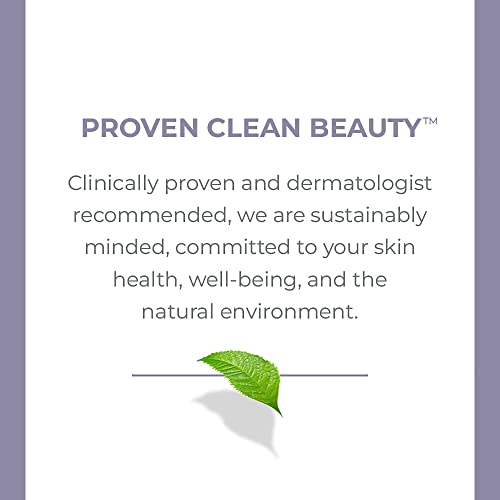
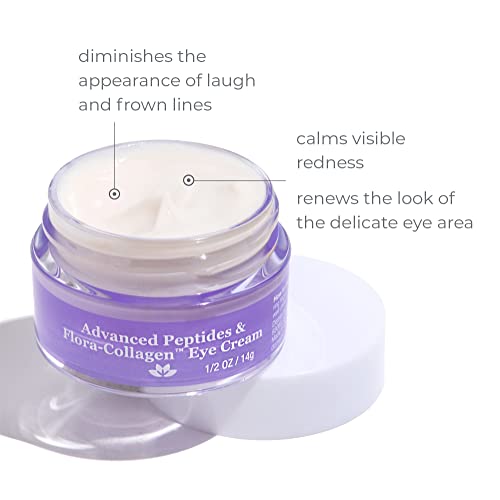
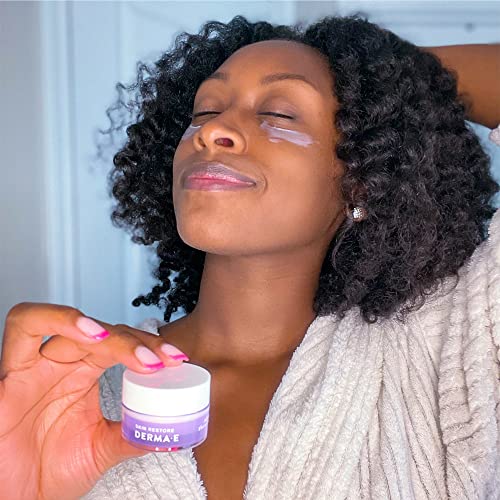
Derma E Eye Cream - Visibly Reduces Wrinkles, Hydrating Vegan Flora-Collagen - 1/2 Oz


Chamomilla Recutita (Matricaria) Flower
High RiskChamomilla recutita (Matricaria) flower, commonly known as chamomile, is a botanical ingredient used primarily for its soothing properties in cosmetic formulations. It is often included in products designed for sensitive skin due to its potential calming effects.
Sustai Insights
Chamomilla recutita offers functional benefits such as skin soothing and anti-inflammatory properties, which can be advantageous in formulations for sensitive skin. However, it is associated with a high allergenic potential, posing risks for individuals with sensitivities. Environmental concerns include its potential as a pollutant, though it is generally not bioaccumulative. Regulatory bodies have noted its low risk for carcinogenicity and reproductive toxicity, yet caution is advised due to allergies. Overall, the risk level is assessed as high, necessitating careful usage and consideration of alternatives for those with sensitivities.
Sodium Hydroxide
High RiskSodium hydroxide is a highly caustic and reactive inorganic compound commonly used as a pH adjuster in various products. It is effective in neutralizing acids and plays a role in the production of soaps and detergents.
Sustai Insights
Sodium hydroxide serves essential functions, particularly in adjusting pH levels, but poses significant health risks, including skin and eye irritation. It is subject to high usage restrictions due to its corrosive nature. Environmental concerns include its potential to pollute water sources and contribute to ecosystem damage. Regulatory bodies have imposed strict guidelines on its use, indicating a high-risk profile for products containing this ingredient. Safe handling practices are crucial, and alternatives include milder pH adjusters, emphasizing the need for caution in its application.
Potassium Sorbate
Medium RiskPotassium sorbate is a potassium salt of sorbic acid, primarily used as a preservative in food and cosmetic products. It inhibits the growth of molds, yeast, and some bacteria, extending the shelf life of products. It is commonly found in various formulations due to its effectiveness and low toxicity.
Sustai Insights
Potassium sorbate serves as an effective preservative, preventing microbial growth in food and cosmetic products, which is vital for safety and longevity. Although it has a low risk of carcinogenicity and developmental toxicity, there is a moderate concern regarding allergies and immunotoxicity. Environmentally, it poses minimal risks as it is not significantly bioaccumulative. Regulatory agencies have verified its use, although some products may face restrictions. Overall, it is assessed as a medium risk ingredient, with safe usage practices recommended, and alternatives such as natural preservatives could be considered.
Phenoxyethanol
Medium RiskPhenoxyethanol is a preservative used in cosmetics and personal care products to prevent microbial growth and extend shelf life. It is commonly found in formulations such as lotions, creams, and serums.
Sustai Insights
Phenoxyethanol serves effectively as a preservative, ensuring product stability and safety by inhibiting microbial growth. It is considered to have low health risks regarding carcinogenicity, allergies, and reproductive toxicity. However, moderate use restrictions exist, and regulatory bodies have advised caution in specific applications. Environmental concerns include its potential as a pollutant, although it is not highly bioaccumulative. Overall, the ingredient presents a medium risk level, with safe usage practices recommended and alternative preservatives available for those seeking greener options.
Camellia Sinensis (Green Tea) Leaf Extract
Medium RiskCamellia sinensis (green tea) leaf extract is derived from the leaves of the Camellia sinensis plant, primarily known for its antioxidant properties. It is commonly used in cosmetic formulations for its potential to soothe the skin and provide protective benefits against environmental stressors.
Sustai Insights
Camellia sinensis leaf extract offers functional benefits, including antioxidant properties that may protect the skin from damage and enhance product efficacy. While generally regarded as safe, it presents moderate allergenic potential and low concerns for carcinogenic or reproductive toxicity. Environmental risks are minimal; however, the sourcing practices should be evaluated for sustainability. Regulatory bodies do not impose significant restrictions, indicating a low-risk profile overall. Safe usage practices are advisable, and alternatives include other botanical extracts with similar benefits.
Dimethicone
Medium RiskDimethicone, also known as polymethylsiloxane, is a silicone-based polymer commonly used in personal care products for its smooth application and skin conditioning properties. It acts primarily as an emollient, providing a silky feel while forming a protective barrier on the skin.
Sustai Insights
Dimethicone provides functional benefits as an effective emollient and skin protectant, contributing to product stability and sensory attributes. It is considered low risk for carcinogenicity, allergies, and reproductive toxicity, but has moderate usage restrictions due to environmental persistence and bioaccumulation concerns. Regulatory bodies have issued advisories regarding its use in certain formulations. Overall, its risk level is assessed as medium, and users are advised to follow recommended usage practices. Alternatives like natural oils or butters may offer sustainable options.
Caprylic Triglyceride
Low RiskCaprylic triglyceride is an ester derived from coconut oil and glycerin, commonly used in cosmetic formulations as an emollient, stabilizer, and skin-conditioning agent. It helps to improve the texture and spreadability of products while providing a lightweight, non-greasy feel.
Sustai Insights
Caprylic triglyceride offers functional benefits such as enhanced skin moisturization and improved formulation stability. It is generally regarded as safe, with low concerns regarding carcinogenicity, allergenic potential, and reproductive toxicity. Environmental impact is minimal, with no significant pollutant or bioaccumulative properties identified. Regulatory bodies have not issued warnings or restrictions. Overall, the risk level is low, making it a suitable ingredient in cosmetic products. Safe usage practices include adhering to recommended concentrations, and while there are alternatives, caprylic triglyceride remains a reliable choice.
Acetyl Hexapeptide 8
Low RiskAcetyl hexapeptide-8 is a synthetic peptide commonly used in cosmetic formulations. It functions primarily as a skin-conditioning agent, often included for its purported ability to reduce the appearance of wrinkles and fine lines by mimicking the effects of botulinum toxin.
Sustai Insights
Acetyl hexapeptide-8 offers functional benefits, particularly in skin care, where it may help diminish wrinkles. It is regarded as low-risk for health concerns such as carcinogenicity, allergies, and neurotoxicity. Environmental risks are minimal, with no significant pollutant or bioaccumulation potential noted. Regulatory assessments indicate no major restrictions. Safe usage practices should be followed, and alternatives like natural peptides may be considered for those seeking more sustainable options. Overall, this ingredient is assessed as low risk.
Simmondsia Chinensis (Jojoba)
Low RiskSimmondsia chinensis, commonly known as jojoba, is an oil derived from the seeds of the jojoba plant. It is commonly used in cosmetic formulations for its moisturizing properties, acting as an emollient and skin conditioning agent.
Sustai Insights
Jojoba oil offers functional benefits such as effective skin moisturization and is biodegradable, with sustainable sourcing practices. Health risks are low, with minimal concerns regarding carcinogenicity, allergies, and reproductive toxicity. Environmental impact is negligible, with no pollutant or bioaccumulation potential. Regulatory status is favorable with no significant restrictions noted. Overall, it is assessed as low risk, and safe usage practices should be maintained. Alternatives include other plant-derived oils like argan or almond oil, which may provide similar benefits.
Palmitoyl Tripeptide 38
Low RiskPalmitoyl tripeptide-38 is a synthetic peptide commonly used in cosmetic formulations, primarily for its role in promoting skin elasticity and reducing the appearance of wrinkles. It functions by stimulating the production of collagen and other essential skin components, contributing to improved skin texture and firmness.
Sustai Insights
Palmitoyl tripeptide-38 offers functional benefits as a skin conditioning agent, enhancing collagen synthesis for anti-aging effects. It has low health risks, with negligible concerns regarding carcinogenicity, allergies, and neurotoxicity. Environmentally, it poses minimal hazards and is not bioaccumulative. Currently, there are no regulatory restrictions on its use, supporting its favorable risk profile. Overall, it is considered low risk, making it a viable option in cosmetic applications. For those seeking alternatives, other peptides or natural extracts may offer similar benefits.
Xanthan Gum
Low RiskXanthan gum is a polysaccharide, a sugar-based compound produced by the fermentation of glucose or sucrose. It is commonly used as a thickening agent and stabilizer in various food and cosmetic products due to its ability to improve texture and prevent ingredient separation.
Sustai Insights
Xanthan gum serves effectively as a thickener and stabilizer, enhancing product texture and consistency. It is biodegradable and typically derived from renewable sources, supporting sustainability efforts. Health risks are minimal, with low concerns regarding carcinogenicity, allergies, and reproductive toxicity. Environmental impact is similarly low, posing no significant hazards. Regulatory agencies, including the FDA, regard it as safe for use, with no significant restrictions. Overall, xanthan gum is assessed as low risk, making it a suitable ingredient in formulations.
Allantoin
Low RiskAllantoin is a naturally occurring nitrogenous compound found in various plants and animals. It is commonly used in cosmetic formulations for its soothing and moisturizing properties, as well as its ability to promote skin cell turnover and healing.
Sustai Insights
Allantoin offers functional benefits such as skin soothing, hydration, and promoting cell regeneration. It is generally recognized as safe, with low concerns regarding carcinogenicity, allergies, and reproductive toxicity. Environmentally, it poses minimal risks, being biodegradable and sustainably sourced. Regulatory bodies do not impose significant restrictions on its use. Overall, the risk level associated with allantoin is low, making it a favorable ingredient in personal care products.
Hydroxypropyl Cyclodextrin
Low RiskHydroxypropyl cyclodextrin is a propylene glycol derivative of cyclodextrin, commonly used in cosmetic formulations as a stabilizing and solubilizing agent. It helps enhance the delivery of active ingredients and improve product texture without altering the overall formulation significantly.
Sustai Insights
Hydroxypropyl cyclodextrin serves as an effective solubilizer and stabilizer in cosmetics, facilitating enhanced delivery of active ingredients. It is generally regarded as safe, with low concerns regarding carcinogenicity, allergies, and reproductive toxicity. Environmental impacts are minimal, as it does not exhibit significant pollutant potential or bioaccumulation. However, it is subject to usage restrictions in verified products. Overall, it presents a low risk, making it a suitable choice in cosmetic formulations.
Ascorbyl Palmitate (Vitamin C Palmitate)
Low RiskAscorbyl palmitate, also known as vitamin C palmitate, is a compound formed by the esterification of ascorbic acid (vitamin C) and palmitic acid. It is primarily used in cosmetic and food products for its antioxidant properties and as a stabilizer for formulations containing fats and oils.
Sustai Insights
Ascorbyl palmitate offers functional benefits as an antioxidant, contributing to product stability and potentially enhancing skin health. It is generally regarded as safe, with low concerns regarding carcinogenicity, allergies, and reproductive toxicity. However, there are considerations regarding biochemical changes at a cellular level, and while it poses minimal environmental risks, it is essential to follow regulatory guidelines. Overall, the risk level is low, making it a suitable ingredient in various applications. Alternatives include other antioxidants like tocopherols for similar benefits.
Glyceryl Stearate Citrate
Low RiskGlyceryl stearate citrate is a citric acid ester of glycerol and stearic acid, commonly used as an emulsifier and stabilizer in cosmetic formulations. It helps blend oil and water components, enhancing product texture and consistency.
Sustai Insights
Glyceryl stearate citrate offers functional benefits as an effective emulsifier, improving product stability and texture. It is considered safe, with low concerns for cancer, allergies, and reproductive toxicity. However, it may cause skin irritation in some individuals. Environmental risks are minimal, with no significant bioaccumulation or pollutant potential. Regulatory bodies have not placed significant restrictions on its use. Overall, the ingredient is assessed as low risk, with safe usage practices recommended, and alternatives may include other emulsifiers like cetearyl alcohol.
Ethylhexylglycerin
Low RiskEthylhexylglycerin is a glyceryl ether utilized primarily as a skin-conditioning agent and preservative in cosmetic formulations. It enhances the efficacy of preservatives and serves as a humectant, helping to retain moisture in the skin. This ingredient is commonly found in various personal care products.
Sustai Insights
Ethylhexylglycerin offers functional benefits as an effective preservative and skin-conditioning agent, contributing to product longevity and moisture retention. Health risks are generally low, with minor concerns regarding allergic contact dermatitis and irritant potential. Environmentally, it poses minimal risks, not being recognized as a pollutant or bioaccumulative. Regulatory bodies have imposed few restrictions, indicating its safety for use. Overall, its risk level is assessed as low, making it a viable option in cosmetic formulations. For those seeking alternatives, ingredients like propanediol may serve similar functions with potentially lower irritation profiles.
Aesculus Hippocastanum (Horse Chestnut) Seed Extract
Low RiskAesculus hippocastanum (horse chestnut) seed extract is derived from the seeds of the horse chestnut tree. It is commonly used in cosmetic and personal care products for its potential anti-inflammatory and soothing properties. The extract contains compounds such as aescin, which may contribute to its functional benefits.
Sustai Insights
Aesculus hippocastanum offers functional benefits as a soothing agent and anti-inflammatory, making it effective in formulations aimed at reducing skin irritation. It is regarded as sustainably sourced with low environmental impact. Health risks are minimal, with low concerns for carcinogenicity and allergies. Regulatory bodies do not impose significant restrictions, affirming its safe use. Overall, the risk level is low, indicating a favorable profile for use in cosmetic formulations. Users should adhere to recommended concentrations, and alternatives, such as plant-based extracts with similar properties, may be considered for enhanced sustainability.
Cetyl Alcohol
Low RiskCetyl alcohol is a long-chain organic alcohol commonly used in cosmetic formulations. It serves as an emollient, emulsifier, and thickening agent, enhancing the texture and stability of products. Cetyl alcohol is derived from natural sources, such as coconut or palm oil, and is often included in creams, lotions, and hair conditioners.
Sustai Insights
Cetyl alcohol offers functional benefits as an emollient and emulsifier, improving product texture and stability. It is biodegradable and sourced from renewable materials, contributing to sustainability. Health risks are minimal, with low concerns for carcinogenicity, allergies, or reproductive toxicity. Environmental impact is also low, with no significant pollutant or bioaccumulation potential. Regulatory bodies have not placed restrictions on its use, indicating a favorable safety profile. Overall, cetyl alcohol is assessed as low risk, and safe usage practices include ensuring proper formulation concentrations.
Stearic Acid
Low RiskStearic acid is a naturally occurring fatty acid commonly found in animal and vegetable fats. It functions primarily as an emulsifier, thickener, and stabilizer in cosmetic and personal care products, providing texture and consistency.
Sustai Insights
Stearic acid offers functional benefits such as effective emulsification and stabilization of formulations. It is derived from renewable sources and is biodegradable, contributing to its sustainability profile. Health risks are low, with minimal concerns regarding carcinogenicity, allergies, or reproductive toxicity. Environmental risks are also low, with no significant pollutants or bioaccumulation concerns noted. Regulatory bodies, including the FDA, do not impose restrictions on its use. Overall, stearic acid is assessed as low risk, and its safe usage practices are well-established, with no significant alternatives needed.
Vegetarian Glycerin
Low RiskVegetarian glycerin, also known as glycerol, is a colorless, odorless, and viscous liquid derived from plant sources. It is primarily used as a humectant, solvent, and emollient in various personal care products, helping to retain moisture and improve texture.
Sustai Insights
Vegetarian glycerin offers functional benefits as an effective humectant, promoting hydration and skin smoothness. It is biodegradable and typically sustainably sourced. Health risks associated with glycerin are low, with no significant concerns for carcinogenicity, allergens, or reproductive toxicity. Environmental risks are minimal, and it is not subject to major regulatory warnings. Overall, the risk level for this ingredient is low, making it a safe choice in formulations. Safe usage practices include ensuring proper concentrations in products, and alternatives such as propylene glycol exist but may have differing properties.
Acacia Seyal Gum Extract
Low RiskAcacia seyal gum extract is a natural polysaccharide derived from the Acacia seyal tree. It functions primarily as a thickening agent and emulsifier in various cosmetic and personal care products, contributing to texture and stability.
Sustai Insights
Acacia seyal gum extract offers functional benefits such as enhancing product consistency and stability, with a low risk of allergenic reactions, carcinogenicity, or developmental toxicity. Environmentally, it is considered low risk, as it does not contribute significantly to pollution or bioaccumulation. Regulatory bodies have not issued any restrictions, affirming its safety status. Overall, it is assessed as low risk, with safe usage practices encouraged. Alternatives include other natural gums like xanthan gum, which may provide similar properties.
Caprylic Triglyceride
Low RiskCaprylic triglyceride is an ester derived from coconut oil and glycerin, commonly used in cosmetic formulations as an emollient, stabilizer, and skin-conditioning agent. It helps to improve the texture and spreadability of products while providing a lightweight, non-greasy feel.
Sustai Insights
Caprylic triglyceride offers functional benefits such as enhanced skin moisturization and improved formulation stability. It is generally regarded as safe, with low concerns regarding carcinogenicity, allergenic potential, and reproductive toxicity. Environmental impact is minimal, with no significant pollutant or bioaccumulative properties identified. Regulatory bodies have not issued warnings or restrictions. Overall, the risk level is low, making it a suitable ingredient in cosmetic products. Safe usage practices include adhering to recommended concentrations, and while there are alternatives, caprylic triglyceride remains a reliable choice.
Potassium Sorbate
Medium RiskPotassium sorbate is a potassium salt of sorbic acid, primarily used as a preservative in food and cosmetic products. It inhibits the growth of molds, yeast, and some bacteria, extending the shelf life of products. It is commonly found in various formulations due to its effectiveness and low toxicity.
Sustai Insights
Potassium sorbate serves as an effective preservative, preventing microbial growth in food and cosmetic products, which is vital for safety and longevity. Although it has a low risk of carcinogenicity and developmental toxicity, there is a moderate concern regarding allergies and immunotoxicity. Environmentally, it poses minimal risks as it is not significantly bioaccumulative. Regulatory agencies have verified its use, although some products may face restrictions. Overall, it is assessed as a medium risk ingredient, with safe usage practices recommended, and alternatives such as natural preservatives could be considered.
Acetyl Hexapeptide 8
Low RiskAcetyl hexapeptide-8 is a synthetic peptide commonly used in cosmetic formulations. It functions primarily as a skin-conditioning agent, often included for its purported ability to reduce the appearance of wrinkles and fine lines by mimicking the effects of botulinum toxin.
Sustai Insights
Acetyl hexapeptide-8 offers functional benefits, particularly in skin care, where it may help diminish wrinkles. It is regarded as low-risk for health concerns such as carcinogenicity, allergies, and neurotoxicity. Environmental risks are minimal, with no significant pollutant or bioaccumulation potential noted. Regulatory assessments indicate no major restrictions. Safe usage practices should be followed, and alternatives like natural peptides may be considered for those seeking more sustainable options. Overall, this ingredient is assessed as low risk.
Simmondsia Chinensis (Jojoba)
Low RiskSimmondsia chinensis, commonly known as jojoba, is an oil derived from the seeds of the jojoba plant. It is commonly used in cosmetic formulations for its moisturizing properties, acting as an emollient and skin conditioning agent.
Sustai Insights
Jojoba oil offers functional benefits such as effective skin moisturization and is biodegradable, with sustainable sourcing practices. Health risks are low, with minimal concerns regarding carcinogenicity, allergies, and reproductive toxicity. Environmental impact is negligible, with no pollutant or bioaccumulation potential. Regulatory status is favorable with no significant restrictions noted. Overall, it is assessed as low risk, and safe usage practices should be maintained. Alternatives include other plant-derived oils like argan or almond oil, which may provide similar benefits.
Palmitoyl Tripeptide 38
Low RiskPalmitoyl tripeptide-38 is a synthetic peptide commonly used in cosmetic formulations, primarily for its role in promoting skin elasticity and reducing the appearance of wrinkles. It functions by stimulating the production of collagen and other essential skin components, contributing to improved skin texture and firmness.
Sustai Insights
Palmitoyl tripeptide-38 offers functional benefits as a skin conditioning agent, enhancing collagen synthesis for anti-aging effects. It has low health risks, with negligible concerns regarding carcinogenicity, allergies, and neurotoxicity. Environmentally, it poses minimal hazards and is not bioaccumulative. Currently, there are no regulatory restrictions on its use, supporting its favorable risk profile. Overall, it is considered low risk, making it a viable option in cosmetic applications. For those seeking alternatives, other peptides or natural extracts may offer similar benefits.
Phenoxyethanol
Medium RiskPhenoxyethanol is a preservative used in cosmetics and personal care products to prevent microbial growth and extend shelf life. It is commonly found in formulations such as lotions, creams, and serums.
Sustai Insights
Phenoxyethanol serves effectively as a preservative, ensuring product stability and safety by inhibiting microbial growth. It is considered to have low health risks regarding carcinogenicity, allergies, and reproductive toxicity. However, moderate use restrictions exist, and regulatory bodies have advised caution in specific applications. Environmental concerns include its potential as a pollutant, although it is not highly bioaccumulative. Overall, the ingredient presents a medium risk level, with safe usage practices recommended and alternative preservatives available for those seeking greener options.
Xanthan Gum
Low RiskXanthan gum is a polysaccharide, a sugar-based compound produced by the fermentation of glucose or sucrose. It is commonly used as a thickening agent and stabilizer in various food and cosmetic products due to its ability to improve texture and prevent ingredient separation.
Sustai Insights
Xanthan gum serves effectively as a thickener and stabilizer, enhancing product texture and consistency. It is biodegradable and typically derived from renewable sources, supporting sustainability efforts. Health risks are minimal, with low concerns regarding carcinogenicity, allergies, and reproductive toxicity. Environmental impact is similarly low, posing no significant hazards. Regulatory agencies, including the FDA, regard it as safe for use, with no significant restrictions. Overall, xanthan gum is assessed as low risk, making it a suitable ingredient in formulations.
Allantoin
Low RiskAllantoin is a naturally occurring nitrogenous compound found in various plants and animals. It is commonly used in cosmetic formulations for its soothing and moisturizing properties, as well as its ability to promote skin cell turnover and healing.
Sustai Insights
Allantoin offers functional benefits such as skin soothing, hydration, and promoting cell regeneration. It is generally recognized as safe, with low concerns regarding carcinogenicity, allergies, and reproductive toxicity. Environmentally, it poses minimal risks, being biodegradable and sustainably sourced. Regulatory bodies do not impose significant restrictions on its use. Overall, the risk level associated with allantoin is low, making it a favorable ingredient in personal care products.
Hydroxypropyl Cyclodextrin
Low RiskHydroxypropyl cyclodextrin is a propylene glycol derivative of cyclodextrin, commonly used in cosmetic formulations as a stabilizing and solubilizing agent. It helps enhance the delivery of active ingredients and improve product texture without altering the overall formulation significantly.
Sustai Insights
Hydroxypropyl cyclodextrin serves as an effective solubilizer and stabilizer in cosmetics, facilitating enhanced delivery of active ingredients. It is generally regarded as safe, with low concerns regarding carcinogenicity, allergies, and reproductive toxicity. Environmental impacts are minimal, as it does not exhibit significant pollutant potential or bioaccumulation. However, it is subject to usage restrictions in verified products. Overall, it presents a low risk, making it a suitable choice in cosmetic formulations.
Ascorbyl Palmitate (Vitamin C Palmitate)
Low RiskAscorbyl palmitate, also known as vitamin C palmitate, is a compound formed by the esterification of ascorbic acid (vitamin C) and palmitic acid. It is primarily used in cosmetic and food products for its antioxidant properties and as a stabilizer for formulations containing fats and oils.
Sustai Insights
Ascorbyl palmitate offers functional benefits as an antioxidant, contributing to product stability and potentially enhancing skin health. It is generally regarded as safe, with low concerns regarding carcinogenicity, allergies, and reproductive toxicity. However, there are considerations regarding biochemical changes at a cellular level, and while it poses minimal environmental risks, it is essential to follow regulatory guidelines. Overall, the risk level is low, making it a suitable ingredient in various applications. Alternatives include other antioxidants like tocopherols for similar benefits.
Glyceryl Stearate Citrate
Low RiskGlyceryl stearate citrate is a citric acid ester of glycerol and stearic acid, commonly used as an emulsifier and stabilizer in cosmetic formulations. It helps blend oil and water components, enhancing product texture and consistency.
Sustai Insights
Glyceryl stearate citrate offers functional benefits as an effective emulsifier, improving product stability and texture. It is considered safe, with low concerns for cancer, allergies, and reproductive toxicity. However, it may cause skin irritation in some individuals. Environmental risks are minimal, with no significant bioaccumulation or pollutant potential. Regulatory bodies have not placed significant restrictions on its use. Overall, the ingredient is assessed as low risk, with safe usage practices recommended, and alternatives may include other emulsifiers like cetearyl alcohol.
Ethylhexylglycerin
Low RiskEthylhexylglycerin is a glyceryl ether utilized primarily as a skin-conditioning agent and preservative in cosmetic formulations. It enhances the efficacy of preservatives and serves as a humectant, helping to retain moisture in the skin. This ingredient is commonly found in various personal care products.
Sustai Insights
Ethylhexylglycerin offers functional benefits as an effective preservative and skin-conditioning agent, contributing to product longevity and moisture retention. Health risks are generally low, with minor concerns regarding allergic contact dermatitis and irritant potential. Environmentally, it poses minimal risks, not being recognized as a pollutant or bioaccumulative. Regulatory bodies have imposed few restrictions, indicating its safety for use. Overall, its risk level is assessed as low, making it a viable option in cosmetic formulations. For those seeking alternatives, ingredients like propanediol may serve similar functions with potentially lower irritation profiles.
Camellia Sinensis (Green Tea) Leaf Extract
Medium RiskCamellia sinensis (green tea) leaf extract is derived from the leaves of the Camellia sinensis plant, primarily known for its antioxidant properties. It is commonly used in cosmetic formulations for its potential to soothe the skin and provide protective benefits against environmental stressors.
Sustai Insights
Camellia sinensis leaf extract offers functional benefits, including antioxidant properties that may protect the skin from damage and enhance product efficacy. While generally regarded as safe, it presents moderate allergenic potential and low concerns for carcinogenic or reproductive toxicity. Environmental risks are minimal; however, the sourcing practices should be evaluated for sustainability. Regulatory bodies do not impose significant restrictions, indicating a low-risk profile overall. Safe usage practices are advisable, and alternatives include other botanical extracts with similar benefits.
Aesculus Hippocastanum (Horse Chestnut) Seed Extract
Low RiskAesculus hippocastanum (horse chestnut) seed extract is derived from the seeds of the horse chestnut tree. It is commonly used in cosmetic and personal care products for its potential anti-inflammatory and soothing properties. The extract contains compounds such as aescin, which may contribute to its functional benefits.
Sustai Insights
Aesculus hippocastanum offers functional benefits as a soothing agent and anti-inflammatory, making it effective in formulations aimed at reducing skin irritation. It is regarded as sustainably sourced with low environmental impact. Health risks are minimal, with low concerns for carcinogenicity and allergies. Regulatory bodies do not impose significant restrictions, affirming its safe use. Overall, the risk level is low, indicating a favorable profile for use in cosmetic formulations. Users should adhere to recommended concentrations, and alternatives, such as plant-based extracts with similar properties, may be considered for enhanced sustainability.
Cetyl Alcohol
Low RiskCetyl alcohol is a long-chain organic alcohol commonly used in cosmetic formulations. It serves as an emollient, emulsifier, and thickening agent, enhancing the texture and stability of products. Cetyl alcohol is derived from natural sources, such as coconut or palm oil, and is often included in creams, lotions, and hair conditioners.
Sustai Insights
Cetyl alcohol offers functional benefits as an emollient and emulsifier, improving product texture and stability. It is biodegradable and sourced from renewable materials, contributing to sustainability. Health risks are minimal, with low concerns for carcinogenicity, allergies, or reproductive toxicity. Environmental impact is also low, with no significant pollutant or bioaccumulation potential. Regulatory bodies have not placed restrictions on its use, indicating a favorable safety profile. Overall, cetyl alcohol is assessed as low risk, and safe usage practices include ensuring proper formulation concentrations.
Chamomilla Recutita (Matricaria) Flower
High RiskChamomilla recutita (Matricaria) flower, commonly known as chamomile, is a botanical ingredient used primarily for its soothing properties in cosmetic formulations. It is often included in products designed for sensitive skin due to its potential calming effects.
Sustai Insights
Chamomilla recutita offers functional benefits such as skin soothing and anti-inflammatory properties, which can be advantageous in formulations for sensitive skin. However, it is associated with a high allergenic potential, posing risks for individuals with sensitivities. Environmental concerns include its potential as a pollutant, though it is generally not bioaccumulative. Regulatory bodies have noted its low risk for carcinogenicity and reproductive toxicity, yet caution is advised due to allergies. Overall, the risk level is assessed as high, necessitating careful usage and consideration of alternatives for those with sensitivities.
Stearic Acid
Low RiskStearic acid is a naturally occurring fatty acid commonly found in animal and vegetable fats. It functions primarily as an emulsifier, thickener, and stabilizer in cosmetic and personal care products, providing texture and consistency.
Sustai Insights
Stearic acid offers functional benefits such as effective emulsification and stabilization of formulations. It is derived from renewable sources and is biodegradable, contributing to its sustainability profile. Health risks are low, with minimal concerns regarding carcinogenicity, allergies, or reproductive toxicity. Environmental risks are also low, with no significant pollutants or bioaccumulation concerns noted. Regulatory bodies, including the FDA, do not impose restrictions on its use. Overall, stearic acid is assessed as low risk, and its safe usage practices are well-established, with no significant alternatives needed.
Dimethicone
Medium RiskDimethicone, also known as polymethylsiloxane, is a silicone-based polymer commonly used in personal care products for its smooth application and skin conditioning properties. It acts primarily as an emollient, providing a silky feel while forming a protective barrier on the skin.
Sustai Insights
Dimethicone provides functional benefits as an effective emollient and skin protectant, contributing to product stability and sensory attributes. It is considered low risk for carcinogenicity, allergies, and reproductive toxicity, but has moderate usage restrictions due to environmental persistence and bioaccumulation concerns. Regulatory bodies have issued advisories regarding its use in certain formulations. Overall, its risk level is assessed as medium, and users are advised to follow recommended usage practices. Alternatives like natural oils or butters may offer sustainable options.
Vegetarian Glycerin
Low RiskVegetarian glycerin, also known as glycerol, is a colorless, odorless, and viscous liquid derived from plant sources. It is primarily used as a humectant, solvent, and emollient in various personal care products, helping to retain moisture and improve texture.
Sustai Insights
Vegetarian glycerin offers functional benefits as an effective humectant, promoting hydration and skin smoothness. It is biodegradable and typically sustainably sourced. Health risks associated with glycerin are low, with no significant concerns for carcinogenicity, allergens, or reproductive toxicity. Environmental risks are minimal, and it is not subject to major regulatory warnings. Overall, the risk level for this ingredient is low, making it a safe choice in formulations. Safe usage practices include ensuring proper concentrations in products, and alternatives such as propylene glycol exist but may have differing properties.
Sodium Hydroxide
High RiskSodium hydroxide is a highly caustic and reactive inorganic compound commonly used as a pH adjuster in various products. It is effective in neutralizing acids and plays a role in the production of soaps and detergents.
Sustai Insights
Sodium hydroxide serves essential functions, particularly in adjusting pH levels, but poses significant health risks, including skin and eye irritation. It is subject to high usage restrictions due to its corrosive nature. Environmental concerns include its potential to pollute water sources and contribute to ecosystem damage. Regulatory bodies have imposed strict guidelines on its use, indicating a high-risk profile for products containing this ingredient. Safe handling practices are crucial, and alternatives include milder pH adjusters, emphasizing the need for caution in its application.
Acacia Seyal Gum Extract
Low RiskAcacia seyal gum extract is a natural polysaccharide derived from the Acacia seyal tree. It functions primarily as a thickening agent and emulsifier in various cosmetic and personal care products, contributing to texture and stability.
Sustai Insights
Acacia seyal gum extract offers functional benefits such as enhancing product consistency and stability, with a low risk of allergenic reactions, carcinogenicity, or developmental toxicity. Environmentally, it is considered low risk, as it does not contribute significantly to pollution or bioaccumulation. Regulatory bodies have not issued any restrictions, affirming its safety status. Overall, it is assessed as low risk, with safe usage practices encouraged. Alternatives include other natural gums like xanthan gum, which may provide similar properties.
Discover the Derma E Advanced Peptides and Vegan Flora-Collagen Eye Cream, a powerful anti-aging moisturizer designed to rejuvenate the delicate eye area. This eye cream not only smooths the appearance of crow's feet and fine lines but also nourishes skin for a radiant, youthful look.
- Visible Results: Clinically proven with 100% of users experiencing improved skin elasticity and 97% noting a reduction in fine lines after just six weeks.
- Natural Ingredients: Formulated with patented peptides and plant-derived Flora-Collagen to support collagen production and enhance hydration.
- Daily Use: Perfect for morning and evening application, this cream easily fits into any skincare routine and works well under makeup.
- Eco-Conscious Choice: 100% vegan and cruelty-free, free from harmful chemicals like parabens and sulfates, and packaged in recyclable materials.
- Trustworthy Brand: Derma E is committed to clean beauty, ensuring transparency and integrity in every product, fostering a loyal customer base.
Subscribe & Save with Sustai
- Best Price Guarantee: Always enjoy the lowest prices on sustainable home essentials.
- No Surprises: We’ll notify you before shipping. No hidden fees, ever.
- You’re in Charge: Change, pause, or cancel your subscription anytime with ease.
- Eco-Friendly Deliveries: Our grouped shipments mean less packaging and lower emissions.
Join us on a sustainable journey. Special offers for a limited time! Prices and promotions may change.
Recommended Products
Discover the Derma E Advanced Peptides and Vegan Flora-Collagen Eye Cream, a powerful anti-aging moisturizer designed to rejuvenate the delicate eye area. This eye cream not only smooths the appearance of crow's feet and fine lines but also nourishes skin for a radiant, youthful look.
- Visible Results: Clinically proven with 100% of users experiencing improved skin elasticity and 97% noting a reduction in fine lines after just six weeks.
- Natural Ingredients: Formulated with patented peptides and plant-derived Flora-Collagen to support collagen production and enhance hydration.
- Daily Use: Perfect for morning and evening application, this cream easily fits into any skincare routine and works well under makeup.
- Eco-Conscious Choice: 100% vegan and cruelty-free, free from harmful chemicals like parabens and sulfates, and packaged in recyclable materials.
- Trustworthy Brand: Derma E is committed to clean beauty, ensuring transparency and integrity in every product, fostering a loyal customer base.

You can have at most 2 Sustainable Steals products in your cart
Customer Reviews
Customers’ View
Customers appreciate the effectiveness and quality of the Eye Cream, noting it as one of the best they've tried. Key benefits highlighted include its moisturizing properties, which add significant hydration and leave skin feeling soft and smooth. Many users report noticeable improvements in skin texture and a reduction in fine lines and wrinkles around the eyes. The product's formulation with natural ingredients, such as peptides and plant extracts, resonates well with health-conscious consumers, as it is free from harmful additives and is 100% vegan and cruelty-free. However, some customers have expressed concerns regarding the durability of the lid. Overall, users find this eye cream effective and aligned with their eco-friendly and health-oriented lifestyle.
AI-generated from the text of customer reviewsThis product is rated 4.5 of 5.0 stars.
It has received 4 reviews.




